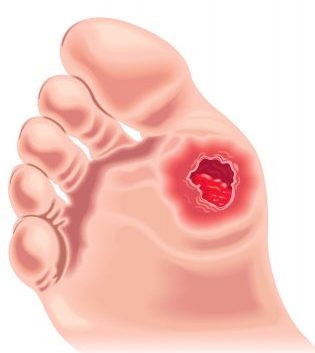Table of Contents
Diabetic Complications
People living with diabetes are prone to having foot problems, often because of two complications of diabetes: nerve damage (neuropathy) and poor circulation. Neuropathy causes loss of feeling in your feet, taking away your ability to feel pain and discomfort, so you may not detect an injury or irritation. Poor circulation in your feet reduces your ability to heal, making it hard for even a tiny cut to resist infection.
Having diabetes increases the risk of developing a wide range of foot problems. Furthermore, with diabetes, small foot problems can turn into serious complications.
Diabetes-Related Foot & Leg Problems
Infections and ulcers (sores) that do not heal
Corns and calluses
Dry, cracked skin
Nail disorders
Hammertoes and bunions
Charcot foot

Poor circulation
Treatment
Managing diabetes by controlling the blood glucose (especially hemoglobin A1C) is the primary focus to avoid developing complications.
Your podiatrist can help wounds heal, prevent infection or amputation. Many new surgical techniques are available to save feet and legs, including joint reconstruction and wound healing technologies. Getting regular foot checkups and seeking immediate help when you notice something can keep small problems from worsening. Your foot and ankle doctor works together with other healthcare providers to prevent and treat complications from diabetes.
Proactive Measures
You play a vital role in reducing complications. Follow these guidelines and contact your foot and ankle surgeon if you notice any problems:
- Inspect your feet daily. If your eyesight is poor, have someone else do it for you. Inspect for:
- Skin or nail problems: Look for cuts, scrapes, redness, drainage, swelling, bad odor, rash, discoloration, loss of hair on toes, injuries or nail changes (deformed, striped, yellowed or discolored, thickened or not growing).
- Signs of fracture: If your foot is swollen, red or hot or has changed in size, shape or direction, see your doctor immediately.
- Do not ignore leg pain. Pain in the leg that occurs at night or with a little activity could mean you have a blocked artery. Seek care immediately. These issues can worsen very quickly.
- Nail cutting. If you have any ingrown nail problems, hard or thickened nails, or reduced feeling in your feet, your toenails should be properly trimmed.
- No “bathroom surgery.” Never trim calluses or corns yourself, and do not use over-the-counter medicated pads.
- Keep floors free of sharp objects. Make sure no needles, insulin syringes or other sharp objects are on the floor.
- Do not go barefoot. Wear shoes, indoors and outdoors. If you absolutely despise wearing closed shoes, there are many sandals out there that provide a certain level of protection.
- Check shoes and socks. Shake out your shoes before putting them on. Make sure your socks are not bunched up.
- Have your circulation and sense of feeling tested. Your doctor will perform tests to see if you have lost any feeling or circulation. At California Foot and Ankle Institute, we perform in-house circulation testing with the Revo 1100 Non-Invasive Vascular Testing System.



